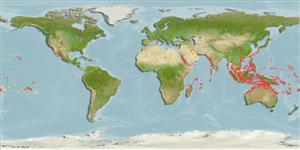>
Ovalentaria/misc (Various families in series Ovalentaria) >
Plesiopidae (Roundheads) > Plesiopinae
Etymology: Calloplesiops: Greek, kalos, kallos = beautiful + Greek, plesios = near, neighbour + Greek, ops = appearance (Ref. 45335).
More on author: Steindachner.
Environment: milieu / climate zone / depth range / distribution range
Οικολογία
Θαλασσινό(ά) Υφαλόφιλο(α); εύρος βάθους 3 - 110 m (Ref. 48635), usually 3 - 45 m (Ref. 27115). Tropical; 32°N - 24°S
Indo-Pacific: Red Sea and East Africa to Tonga and the Line Islands.
Μέγεθος / Βάρος / Age
Maturity: Lm ? range ? - ? cm
Max length : 20.0 cm TL αρσενικό/απροσδιόριστο; (Ref. 48635); μεγ. αναφερόμενη ηλικία: 9 έτη
Ραχιαίες άκανθες (συνολικά): 11; Μαλακές ραχιαίες ακτίνες (συνολικά): 8-10; Εδρικές άκανθες 3; Μαλακές εδρικές ακτίνες: 9. Characterized by having tubed lateral-line scales 19-20+9-10; depth of body 2.5-2.7 in SL; dorsal and anal fins elevated posteriorly; rounded caudal fin. The false eye which is actually the dorsal fin ocellus confuses predators because it poses an inverted image of a fish. When alarmed, this fish will poke its head into a hole and expose its tail end which mimics the head of the moray eel (Ref. 9710). Head and body brownish black with small pale blue spots; vertical and pelvic fins dark orange-brown, with many small blue spots; blue ringed black ocellus above base of last 3 dorsal rays; yellow spots at base of upper caudal rays; pectoral rays bright yellow, fin membrane transparent (Ref. 10430).
Adults are found near reefs, and in caves and crevices along drop-offs (Ref. 8631). A nocturnal species that hides under ledges and in holes by day (Ref. 9710). They possess a false eye which is actually the dorsal fin ocellus confuses predators because it poses an inverted image of a fish. When alarmed, this fish will poke it's head into a hole and expose its tail end which mimics the head of the moray eel (Ref. 9710). Eggs are guarded by the male parent (Ref. 205). Have been reared in captivity (Ref. 35426). Reported to be living in a marine aquarium for 8 years and 6 months (Danilo Ronchi, Italy, pers.comm. 2014 February). Maximum depth reported taken from Ref. 128797.
Life cycle and mating behavior
Γεννητική Ωρίμανση | Αναπαραγωγή | Γεννοβολία | Αβγά | Γονιμότητα | Προνύμφες
Eggs are guarded by the male parent (Ref. 205).
Randall, J.E., G.R. Allen and R.C. Steene, 1990. Fishes of the Great Barrier Reef and Coral Sea. University of Hawaii Press, Honolulu, Hawaii. 506 p. (Ref. 2334)
IUCN Red List Status (Ref. 130435)
Threat to humans
Harmless
Human uses
Ενυδρείο: Δημόσια ενυδρεία
Περισσότερες πληροφορίες
ΑναφορέςΥδατοκαλλιέργειεςΠροφίλ υδατοκαλλιέργειαςΣτελέχοιΓενετικήElectrophoresesΚληρονομικότηταΑσθένειεςΜεταποίησηNutrientsMass conversion
ΣυνεργάτεςΦωτογραφίεςStamps, Coins Misc.ΉχοιΣιγκουατέραΤαχύτηταΚολυμβητικός ΤύποςΕπιφάνεια βραγχίωνOtolithsΕγκέφαλοιΌραση
Εργαλεία
Special reports
Download XML
Διαδικτυακές πηγές
Estimates based on models
Preferred temperature (Ref.
123201): 24.9 - 29, mean 27.8 °C (based on 1286 cells).
Phylogenetic diversity index (Ref.
82804): PD
50 = 0.7500 [Uniqueness, from 0.5 = low to 2.0 = high].
Bayesian length-weight: a=0.01995 (0.00906 - 0.04395), b=3.01 (2.83 - 3.19), in cm total length, based on all LWR estimates for this body shape (Ref.
93245).
Τροφικό Επίπεδο (Ref.
69278): 4.0 ±0.65 se; based on food items.
Ελαστικότητα (Ref.
120179): Μεσαίο(α), ελάχιστος χρόνος για διπλασιασμό πληθυσμού 1,4 - 4,4 έτη (Fec = 1,000).
Fishing Vulnerability (Ref.
59153): Low vulnerability (10 of 100).
Nutrients (Ref.
124155): Calcium = 63.7 [32.2, 112.1] mg/100g; Iron = 0.583 [0.338, 0.939] mg/100g; Protein = 18.8 [17.6, 19.9] %; Omega3 = 0.128 [0.077, 0.205] g/100g; Selenium = 26.9 [15.3, 51.6] μg/100g; VitaminA = 88.8 [27.1, 292.6] μg/100g; Zinc = 1.1 [0.7, 1.6] mg/100g (wet weight);
